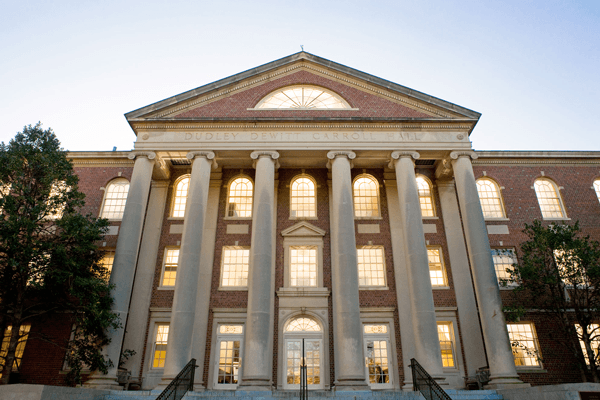Story by Harry Crowther
There once was just one tree in the space that is now the Coker Arboretum.
UNC-Chapel Hill consisted of only about 800 students. Howell Hall did not exist. Neither did the Morehead Planetarium. Only half of Davie Hall had been built. Raleigh Street was a small dirt track, and there were athletic fields on the other side of Cameron Avenue.
Bordered by Raleigh Street to the east and Cameron Avenue to the south, the arboretum’s land was a boggy pasture cultivated by UNC faculty who lived in the nearby village. They would shepherd their mules into the space and let them graze while teaching classes.
More than 120 years later, that overcup oak, Quercus Lyrata, still stands as a symbol of endurance at the heart of an oasis on UNC’s campus. All around the tree over that time, there has been constant growth and decay. The arboretum lives and breathes. And now that oak is part of a rich canopy, one of over 600 different species of plants that thrive in the garden.
“A space to breathe and relax and reconnect with nature,” says Dan Stern, the North Carolina Botanical Gardens’ director of horticulture. “We coexist with the rest of the natural world, and I think the arboretum is a place for us to remember that.”

The Coker Arboretum’s central lawn, with the original overcup oak on the left. The arboretum, which has been at UNC-Chapel Hill for more than 120 years, is home to more than 600 species of plants. Photo by Harry Crowther.
Hundreds of people visit the arboretum every day, whether they pass through on a walk or set up a picnic on the lawn. It has become a Chapel Hill icon that provides a place for learning and quiet respite. Since 1903, the five acres of prime real estate have not been anything else except a lush garden, a place embraced and beloved by the community.
One distinct feature that makes the arboretum special is the Coker Arbor on the southern border adjacent to Cameron Avenue. The arbor has been closed since the fall of 2022 for renovation. Its previous iteration lasted 25 years but was taken down due to deterioration in the wooden structure. Construction is ongoing on the new arbor structure with the hope of reopening next spring after planting.
“It will be a beautiful flower garden,” arboretum curator Geoffrey Neal says. “It’s going to be a lovely addition. I’m excited to get it back online.”
William Chambers Coker began building the original arbor in 1911, nine years after he arrived in Chapel Hill. Francis Preston Venable, the president at the time, hired Coker in 1902 as the University’s first botany professor and the first chair of the University Buildings and Grounds Committee.
The story goes that Venable and Coker were walking on a path through the middle of the pasture when Venable turned to Coker and proposed he do something with the land. Venable gave him a modest stipend to hire one helper and turned him loose. Fresh out of graduate school, Coker’s vision was to create a teaching garden showcasing plants that grow in North Carolina.
“He wanted to grow one of everything that grows in North Carolina,” Neal says. “Laudable goal. Nearly impossible to pull off. But it was that notion that informed his work moving forward.”

A portrait of William Chambers Coker. Courtesy of the North Carolina Botanical Gardens.
Neal has access to one of Coker’s journals from 1910 in which he mapped plans for planting areas and irrigation ditches. Coker quickly learned he wouldn’t be able to grow one of everything like he wanted. Not everything that grows in North Carolina would thrive in the arboretum. Little planting was done during the first years after 1903 because the land was wet and muddy.
All of the trees in the arboretum were planted after 1910. Neal says trees in landscape define space the same way walls define rooms in a home. The arboretum features a diverse collection of spectacular trees, producing clean and fresh oxygen. They create alcoves amidst the plants where people can enjoy the natural ambience and find a pocket of peace on a beautiful day.
As the trees have grown over the years, so too have the town and campus around them. But the arboretum has remained intact and uninterrupted, protected by the community and the University.
“It’s a very quiet support,” Neal says, “the recognition that I know comes from the administration that we are valuable because of the services that we are quietly providing.”
Many people have cared for the arboretum throughout its history. Coker spent 44 years as its caretaker before he retired from the University in 1947. The North Carolina Botanical Gardens took over management of the arboretum from the UNC Grounds Department in the mid-1980s. Stern was curator in the early 2000s, and the role is now Neal’s.
As curator, Neal works with horticulture technician Christine Miller and a team of volunteers and work-study students. He decides which plants stay and which go, with an eye toward what the space will look like decades from now. The goal is to maintain a more natural and wild ecosystem rather than a manicured space.
Neal calls the arboretum a “living museum.” It took him five years to learn all of the plants in the garden. Prominent species include those that are part of Southern vernacular, such as camellias, azaleas and gardenias. The daily tasks for Neal and his team range from planting and mowing to removing invasive species. They do a lot of weeding.
“Part of the ethos of it being a living space is that changes happen all the time,” Miller says. “Things can die, and it’s not the end of the world. Something else will replace it. Things will grow over. It is wrangling a beast in certain ways, and that’s a fun challenge. It’s interesting seeing how different areas grow in different ways.”

The original Coker Arbor as it looked from 1910-1919. Courtesy of the North Carolina Botanical Gardens.
On the to-do list soon will be planting in the new arbor once it is built. The process for the fifth iteration of the arbor began in 2019 with a feasibility study. The North Carolina Botanical Gardens teamed up with UNC Facilities Planning and Design and Raleigh landscape architecture firm Andropogon Associates to create the design for the new arbor and walkway.
“Trying to reimagine that landscape, one that made that walkway up to par with other campus primary walkways,” Stern says. “But also to rethink the structure itself and ways to improve upon the design that would increase visibility, increase safety and increase longevity. We’re anticipating that this renovation is going to last at least 50 years.”
The new arbor will be taller and more robust, made from black locust timbers. There will be new, expanded sitting areas at each end, and the walkway will be ADA compliant.
Following fundraising and approvals, construction began this past summer with earthwork. After the structure is finished this fall, Neal will lead the planting of native vines and flowers with the hope of a grand reopening in April 2026 as everything is in bloom.

Work is underway at the site of the new arbor on the southern border of the Coker Arboretum. The arbor has been closed since 2022. Photo by Harry Crowther.
With the new arbor, the full arboretum experience will return for the first time since 2022. It’s more than just a pretty place. Big or small, subconscious or deeply personal, it’s a place that has an impact on people.
Neal and Miller say one of the highlights of their job is talking to the arboretum’s visitors. People want to talk about plants or just want to thank them for what they do.
“We’re very much trying to cultivate a community space,” Miller says, “which is why we want to know the name of your dog.”
Oliver Hassell is part of that community. They developed a strong connection with the arboretum when they were a student at UNC. They would visit to eat lunch, study or meet friends. Hassell says it’s a place that feels slower and more peaceful than the rest of campus.
After graduating in 2020, Hassell moved away to Denver for four years before returning to Chapel Hill. They heeded a call for volunteers in the arboretum, wanting to give back to the place that was so important to them.
“The arboretum, even though it is one size, the more and more I get to know it, it feels bigger and bigger,” Hassell says. “Because there is so much living here.”
One constant since both Coker and Hassell first walked in the space is the oak tree in the center. While all trees fail, whether by human intervention or natural causes, a healthy oak tree can live for up to 500 years. Neal speculates the oak in the arboretum’s central lawn has lived for about 250 years.
He puts great thought into the future tree canopy of the arboretum. And the first, grand overcup oak will be a part of it for many years to come.
“I would not dream,” Neal says, “of removing that tree.”

The main walkway through the Coker Arboretum on UNC-Chapel Hill’s campus, home to more than 600 species of plants. Photo by Harry Crowther.
 Stories from the UNC Media Hub are written by senior students from various concentrations in the Hussman School of Journalism and Media working together to find, produce and market unique stories — all designed to capture multiple angles and perspectives from across North Carolina.
Stories from the UNC Media Hub are written by senior students from various concentrations in the Hussman School of Journalism and Media working together to find, produce and market unique stories — all designed to capture multiple angles and perspectives from across North Carolina.


